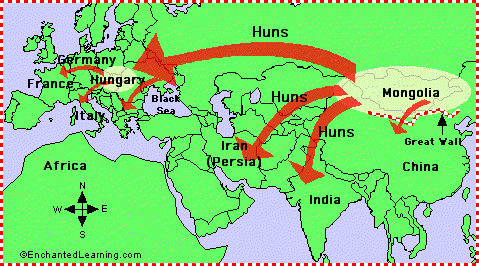Huns, like mongols, was very warlike and roamed over huge track of grassland of central Asia. Eventually Europe:
The Huns were a group of nomadic (roaming) herdsmen, warlike people from the steppes (grasslands) of North Central Asia north of China (Mongolia) who terrorized, pillaged, and destroyed much of Asia and Europe from the 3rd through 5th centuries. The use of the stirrup gave the Huns a technological advantage over other warriors of the time. Stirrups are loops hung from a saddle that support a horse rider's feet; these let the Huns brace themselves on their horses while wielding swords or shooting arrows.

Hordes Attack Asia and Europe: The Chinese successfully defended themselves against the Huns in the 3rd century (the Huns were then led by Mao-tun, the first great leader and uniter of the Huns). The Chinese started building their Great Wall to defend themselves against the Huns. The people of India, Persia (what is now Iran), and eastern and central Europe were invaded by separate hordes of Hunnish warriors attacking on horseback. In Europe, groups of Huns defeated the Goths (Germans) of eastern Europe, the Slavs, the Franks (French), the Roman Empire, and many others. The Huns settled in the area that is now called Hungary.
Rugulas: A Hunnish horde under the leader Rugulas (also called Rua, Roas, or Rugila), attacked the eastern Roman Empire (ruled by Emperor Theodosius) in A.D. 430, forcing the Romans to pay huge tributes of gold to the Huns or face more destruction.
Attila the Hun (born about 406 - died 453): Upon Rugulas' death in 433, Attila and his older brother Bleda (nephews of Rugulas) became co-leaders of the Huns. After killing his own brother in A.D. 445, Attila took control of the Huns. Attila the Hun was the most successful king of the Huns; Attila was often called the "Scourge of God."
Under Attila's rule, the Huns united and extended their territory greatly, reaching ever deeper into Europe. After a defeat at Chalons (in what is now northern France) in A.D. 451, the Huns invaded Italy (in 452), destroying much of northern Italy. [Refugees from a demolished Padua (a city in northeastern Italy) fled and founded the city of Venice, which they built on the water in a lagoon so the new city would be protected from invaders.] Pope Leo I intervened and convinced Attila to stop the destruction of Italy -- Rome was spared (although some historians say that Attila stopped his campaign because of rampant disease and a lack of supplies).
The End of the Huns: Attila died during his sleep on the night of his last wedding -- Attila had many wives. He died from a serious nosebleed (a nasal hemorrhage), but some people say that he was poisoned. After Attila's death, Attila's sons fought over who would rule the Huns. The resulting chaos was exploited by the Ostrogoths and other Germanic tribes, who used the opportunity to revolt against the Huns. The Hunnish empire soon broke apart.
Both the Huns and later on the Mongol's conquest of East and Southern Europe with their brutality earned the title "The scourge of God". There are many souces of info if you are looking for more details. Here is one.
http://history.eserver.org/attila-at-chalons.txt
There are more info on 'Battle of Chalon', Attila's final major battle. It can be found on YOUTUBE.